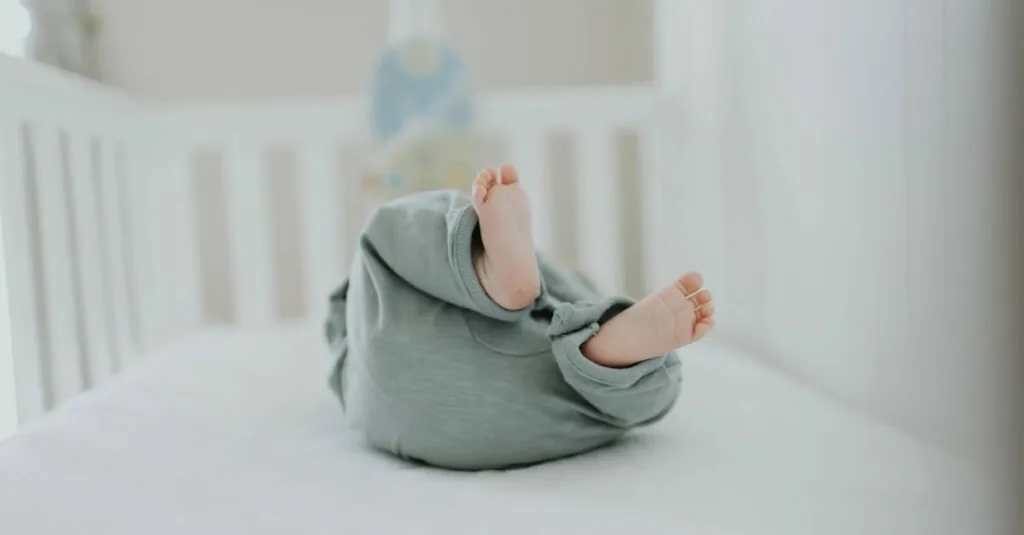Table of Contents
ToggleWhen it comes to getting a good night’s sleep, parents often find themselves in a battle of wills with their little ones. Enter the sleep sack—a cozy, wearable blanket that promises to keep those tiny toes toasty without the risk of blankets slipping off. But can newborns really rock this fashionable sleepwear? Spoiler alert: they can!
Sleep sacks might just be the secret weapon in a parent’s sleep arsenal. Designed to provide warmth and comfort, these snug garments offer a safe alternative to traditional bedding. Plus, they come in adorable designs that might just make your baby the trendsetter of the nursery. So, if you’re wondering whether your newborn can wear a sleep sack, buckle up! This article will unpack the benefits, safety tips, and everything you need to know to make bedtime a breeze.
Overview of Sleep Sacks
Sleep sacks provide a practical sleep solution for newborns. Designed to replace traditional blankets, these wearable blankets prevent the risk of suffocation and overheating. Sleep sacks promote a safe sleep environment, allowing parents to feel secure while their babies rest.
Multiple materials are used in sleep sacks, including cotton, fleece, and muslin, catering to different climates and preferences. Parents often choose lightweight options for warmer weather and thicker fabric for cooler nights. Various sizes and styles ensure a snug fit that accommodates growth during infancy.
Safety features play a crucial role in the design of sleep sacks. Many have built-in safety zippers that allow for easy diaper changes without fully removing the garment. Sleep sacks also provide a swaddle option, which can be comforting for newborns who prefer the feeling of being securely wrapped.
Adopting a sleep sack can enhance a baby’s sleep routine. Consistency in using sleep sacks helps babies associate them with sleep time, signaling the transition to bedtime. The availability of adorable designs appeals to parents and makes bedtime routines more enjoyable.
Focusing on the appropriate age and size of the sleep sack is essential for safety and comfort. Newborns can typically start using sleep sacks right after birth, depending on weight. It’s important to check product labels for guidelines to ensure an ideal fit as babies grow.
Benefits of Sleep Sacks for Newborns
Sleep sacks offer numerous advantages for newborns, enhancing both safety and comfort during sleep.
Safety Considerations
Safety remains a top priority when choosing sleep sacks. They eliminate the risks associated with loose blankets, reducing the chances of suffocation or overheating. Features such as built-in safety zippers facilitate easy diaper changes while keeping the baby securely wrapped. Parents should select sleep sacks designed for the newborn’s size and developmental stage to promote safety. The appropriate fit prevents any slipping or bunching that could pose risks during sleep.
Comfort and Warmth
Comfort and warmth are crucial for a newborn’s sleep experience. Sleep sacks provide a cozy environment that mimics the feeling of being swaddled, promoting a sense of security. Various materials like cotton, fleece, and muslin allow customization based on the climate and personal preferences. Different options cater to temperature variations that newborns may encounter. The snug fit keeps infants comfortably warm while encouraging sleep, creating a supportive atmosphere conducive to rest.
Choosing the Right Sleep Sack
Selecting a suitable sleep sack involves considering various factors. Parents should prioritize material types to ensure comfort and safety for their newborns.
Material Types
Cotton sleep sacks provide breathability and softness, making them ideal for warmer climates. Fleece options offer warmth during colder months. Muslin sleep sacks, known for their lightweight and breathable qualities, support temperature regulation, preventing overheating. It’s important to check for hypoallergenic materials, especially if the baby has sensitive skin. Each material type offers unique benefits, catering to different environmental conditions.
Size and Fit
Choosing the correct size ensures safety and comfort in sleep sacks. A snug fit minimizes the risk of slipping while allowing room for movement. Parents should consult brand size charts, as measurements can vary across manufacturers. Birth weight and length also influence the right choice, as newborns grow quickly. Sleep sacks should maintain a close fit around the neck while being loose enough for leg movement, promoting a secure yet comfortable environment.
Potential Concerns
Parents often worry about potential concerns when using sleep sacks for newborns. Understanding these issues helps ensure a safe sleeping environment.
Overheating Risks
Overheating poses a significant risk for newborns in sleep sacks. fabric choice plays a crucial role; select lightweight, breathable materials to maintain optimal temperature. Wearing too many layers can trap heat, increasing the chances of overheating. Parents should regularly check their baby’s temperature and adjust clothing accordingly. Signs of overheating include sweating, flushed skin, or restlessness. Choosing sleep sacks designed for specific temperature ranges further mitigates this risk. Additionally, monitoring the nursery temperature contributes to safeguarding against overheating.
Restricted Movement
Restricted movement presents another concern with sleep sacks. While the snug fit promotes security, it limits a baby’s ability to move freely. Newborns benefit from some freedom of movement for natural development. Opting for sleep sacks with adjustable features can help accommodate growing babies. Some parents prefer sleep sacks that allow for swaddling while still enabling leg movement. Always consider a balance between security and mobility when selecting a sleep sack. Monitoring the baby’s comfort during sleep periods ensures they receive adequate movement for growth.
Sleep sacks offer a safe and comfortable sleep solution for newborns. They eliminate the risks associated with loose blankets while providing a cozy environment that promotes better sleep. Parents can choose from various materials and designs to suit their baby’s needs and the climate.
Selecting the right size and fit is crucial for safety and comfort. With features like built-in safety zippers and swaddle options, sleep sacks make nighttime routines easier for parents. By incorporating sleep sacks into their baby’s sleep routine, parents can help create a secure atmosphere that fosters restful nights. Ultimately, sleep sacks can be a valuable addition to any newborn’s bedtime essentials.




